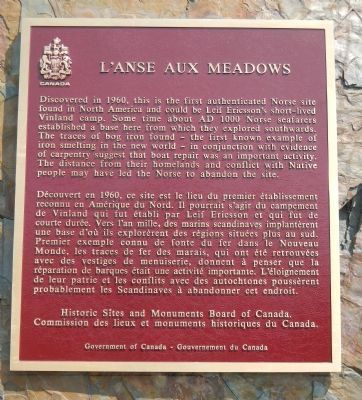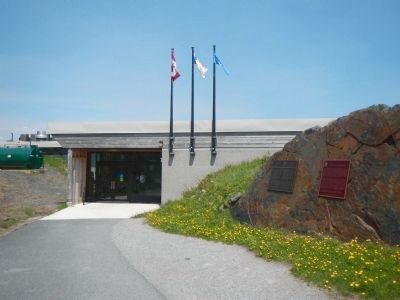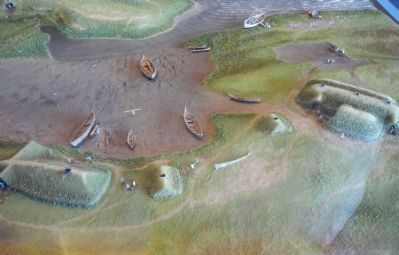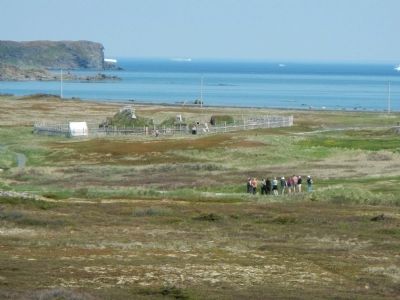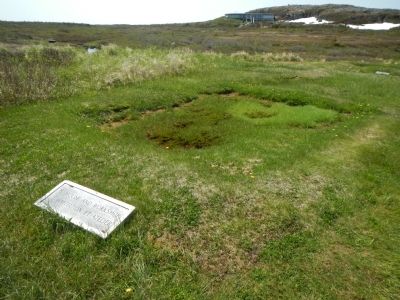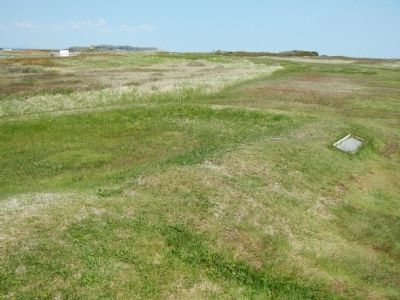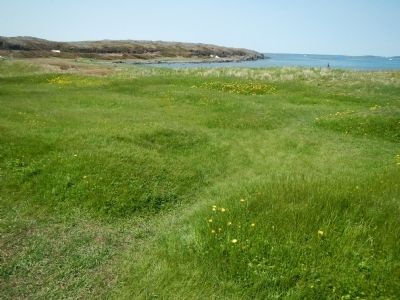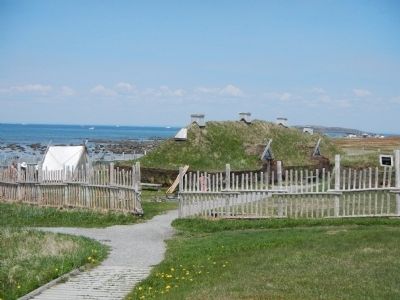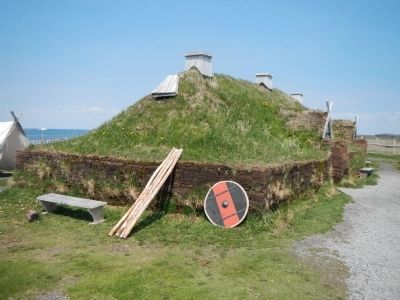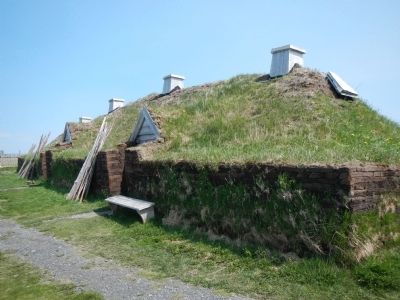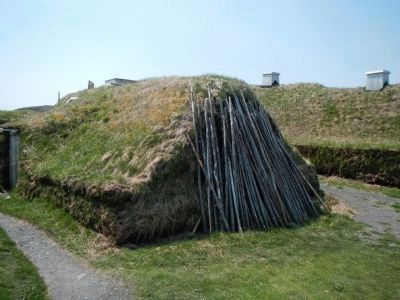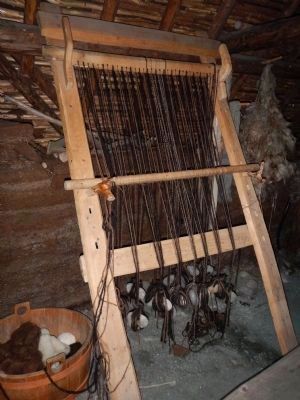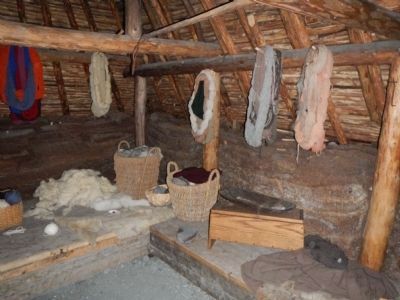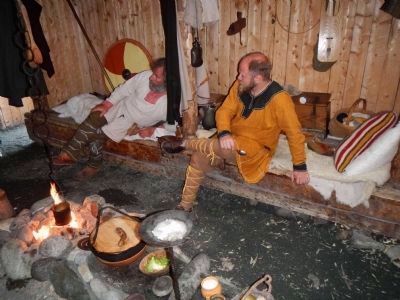Near St Lunaire-Griquet in Great Northern Peninsula, Newfoundland, Newfoundland and Labrador — The Atlantic Provinces (North America)
L’Anse aux Meadows
Discovered in 1960, this is the first authenticated Norse site found in North America and could be Leif Ericsson's short-lived Vinland camp. Some time about AD 1000 Norse seafarers established a base here from which they explored southwards. The traces of bog iron found - the first known example of iron smelting in the new world - in conjunction with evidence of carpentry suggest that boat repair was an important activity. The distance from their homelands and conflict with Native people may have led the Norse to abandon the site.
French:
Découvert en 1960, ce site est le lieu du premier établissement reconnu en Amérique du Nord. Il pourrait s'agir du campement de Vinland qui fut établi par Leif Ericsson et qui fut de courte durée. Vers l'an mille, des marins scandinaves implantèrent une base d'où ils explorèrent des régions situées plus au sud. Premier exemple connu de fonte du fer dans le Nouveau Monde, les traces de fer des marais, qui ont été retrouvées avec des vestiges de menuiserie, donnent à penser que la réparation de barques était une activité importante. L'éloignement de leur patrie et les conflits avec des autochtones poussèrent probablement les Scandinaves à abandonner cet endroit.
Erected by Historic Sites and Monument Board of Canada/Commission de lieux et monuments historique du Canada.
Topics and series. This historical marker is listed in these topic lists: Exploration • Settlements & Settlers. In addition, it is included in the Canada, Historic Sites and Monuments Board series list. A significant historical year for this entry is 1960.
Location. 51° 35.525′ N, 55° 31.982′ W. Marker is near St Lunaire-Griquet, Newfoundland and Labrador, in Great Northern Peninsula, Newfoundland. Marker can be reached from Newfoundland and Labrador Route 436 close to Newfoundland and Labrador Route 430. Touch for map. Marker is in this post office area: St Lunaire-Griquet NL A0K 2X0, Canada. Touch for directions.
Other nearby markers. At least 1 other marker is within walking distance of this marker. The End of a Quest: L’aboutissement d’une quête (within shouting distance of this marker).
More about this marker. L’Anse aux Meadows near the end of Route 436, 30 km from the intersection of Route 430. The marker is located at the Visitors Center, a short walk from the parking lot.
Also see . . .
1. Viking-Age Exploration in North America - Hurstwic. The Norse voyages to North America are described in two Icelandic sagas, Eiríks saga rauða, and Grænlendinga saga. The sagas say that in the year 985, the Icelander Bjarni Herjólfsson was blown off course on his way to Greenland and spotted a new land. Surprisingly, he didn't go ashore, but he did eventually return to Greenland to tell his story. (Submitted on December 11, 2014, by Barry Swackhamer of Brentwood, California.)
2. The Viking Explorer Who Beat Columbus to America - History.com. Archaeologists have unearthed evidence that supports the sagas’ stories of the Norse expeditions to America. In 1960, Norwegian explorer Helge Ingstad scoured the coasts of Labrador and Newfoundland for signs of a possible settlement, and he found it on the northernmost tip of Newfoundland at L’Anse aux Meadows. (Submitted on December 12, 2014, by Barry Swackhamer of Brentwood, California.)
3. Norse colonization of the Americas - Wikipedia. The Norse colony in Greenland lasted for almost 500 years. Continental North American settlements were small and did not develop into permanent colonies. While voyages, for example to collect timber, are likely to have occurred for some time, there is no evidence of enduring Norse settlements on mainland North America. (Submitted on December 12, 2014, by Barry Swackhamer of Brentwood, California.)
Additional keywords. Vikings
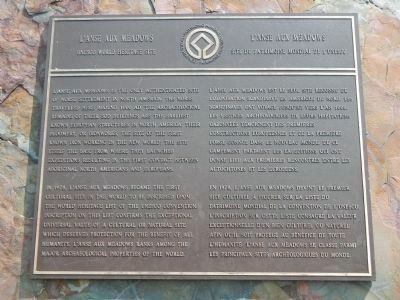
Photographed By Barry Swackhamer, June 28, 2014
15. UNESCO World Heritage Site Plaque
English:
L’Anse aux Meadows is the only authenticated site of Norse settlement in North America. The Norse travelled here around 1000 A.D. The archaeological remains of their sod buildings are the earliest known European structures in North America; their bloomery, or ironworks, the site of the first known iron working in the New World; the site itself the base from where they launched expeditions resulting in the first contact between aboriginal North Americans and Europeans.
In 1978, L’Anse aux Meadows brame the first cultural site in the world to be inscribed upon the world heritage list of the UNESCO convention. Inscription on this list confirms the exceptional universal value of a cultural or natural site which deserves protection for the benefit of all humanity. L’Anse aux Meadows ranks among the major archaeological properties of the world.
French:
L’Anse aux Meadows est le seul site reconnu de colonisation Scandinave en Amérique du nord. Les Scandinaves ont voyagé jusqu’ici vers l’an 1000, Les vestiges archéologiques de leurs habitations gazonnées témoignent des premières constructions Européennes et de la première forge connue dans le nouveau monde. De ce campement partaient les expéditions qui ont donné lieu aux premières rencontres entre les autochtones et les Européens.
En 1978, L’Anse aux Meadows devint le premier site culturel à figurer sur la liste de patrimoine mondial de la convention de l’UNESCO. L’inscription sur cette liste consacre la valeur exceptionnelle d’un bien culturel ou naturel afin qu’il son protégé au bénéfice de toute l’humanité. L’Anse aux Meadows se classe parmi les principaux sites archéologique du monde.
Credits. This page was last revised on June 16, 2016. It was originally submitted on December 11, 2014, by Barry Swackhamer of Brentwood, California. This page has been viewed 630 times since then and 38 times this year. Photos: 1, 2, 3, 4, 5, 6, 7, 8, 9, 10, 11, 12, 13, 14. submitted on December 11, 2014, by Barry Swackhamer of Brentwood, California. 15. submitted on December 12, 2014, by Barry Swackhamer of Brentwood, California. • Andrew Ruppenstein was the editor who published this page.
